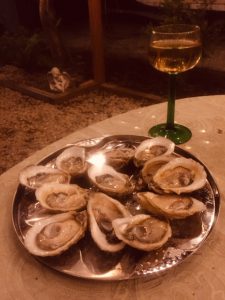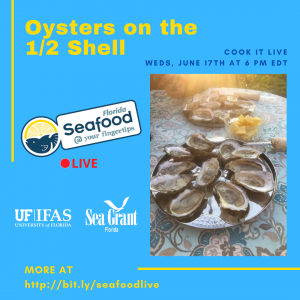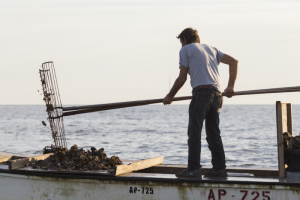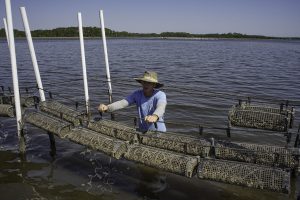In the US, we spend 70% of our seafood consumption at restaurants. As a result, the coronavirus pandemic virtually shut down restaurants and therefore, the majority of the seafood industry. While restaurants were closed, many Florida seafood producers and distributors switched gears to provide fresh seafood directly to consumers. One of those products are oysters. And while we are now just starting to open up restaurants across the state you can still enjoy Fresh from Florida oysters at home.

Raw oysters are among the freshest seafoods that you can eat. They are an excellent source of protein, omega-3 fatty acids and vitamin B12. Oysters also have the highest zinc content of any food. Zinc can improve response to infection. Raw oysters with a splash of lemon juice (Zinc + Vitamin C) may be the ultimate natural immune booster! Oysters are also a very sustainable seafood, so you can feel good about eating them too!
But a big barrier to eating raw oysters at home is that many people don’t know how to shuck an oyster. In my Florida Seafood At Your Fingertips Live! webinar, I show you how to safely shuck oysters so you can enjoy them just like at your favorite raw bar. It’s a really simple, healthy dish, and a great way to support your local seafood industry.
Although oysters can be enjoyed with just a squeeze of lemon, or even nothing at all, I include a classic mignonette sauce to add to your oysters.
Ingredients
- 1 dozen oysters
- Sliced lemons for the oysters
- ¼ cup of your favorite vinegar (red or white wine, champagne, rice vinegar, or combine!)
- 1 tablespoon minced shallots
- ¼ teaspoon of coarsely ground black pepper, or to taste
- Lemon juice and/or zest, to taste
Recipe
- Slice lemons and prepare mignonette sauce before shucking oysters. Mix sauce ingredients and set aside in the refrigerator.
- Shuck oysters carefully and place on serving dish. Place shucked oysters in the refrigerator, or on ice while shucking others. Careful not to spill the juice, or liquor, in the shell!
- Squeeze lemons and/or add sauce to oysters, to taste.
- Slurp and enjoy! Wash down with your favorite white wine.
 Tune in to the Florida Sea Grant Facebook page at 6pm EST on Wednesday, June 17. During the live feed I will answer your questions. In case you miss it, the video will be archived for later viewing.
Tune in to the Florida Sea Grant Facebook page at 6pm EST on Wednesday, June 17. During the live feed I will answer your questions. In case you miss it, the video will be archived for later viewing.
Where to buy oysters
Your local seafood market. A list of Florida seafood markets can be found here. Several aquaculture farms sell direct to consumer as well.
When to buy oysters
Despite the lore of eating oysters only during the “R” months (e.g. September to April), you can still buy quality oysters year-round from Florida oyster farmers, even during the summer, or non-”R” months (May to August). Many farmers sell triploid oysters which do not spawn, remaining meaty during the summer. The advice to only eat oysters during the winter and spring descended from historical fishery regulations that restricted harvesting during the summer months to allow oysters to reproduce (an early sustainable practice!) – not because of concerns over shellfish safety.
That being said, warmer waters still carry a greater risk of bacteria. Nowadays, however, the state regularly monitors shellfish leases to ensure good water quality and a safe product. Shellfish beds will close if water quality is impaired (high bacterial counts and/or during harmful algal blooms). Even with good water quality, there are strict guidelines for handling and processing shellfish from harvest to wholesaler.
How to buy oysters

Ask to see the processing tag to see where and when the oysters were harvested. Try to choose your own oysters. If they are open, they are dead – do not select those (and inform your fish monger). You can rap oysters with another one, and if they sound hollow and feel light in weight compared to others, don’t select those. Always keep in mind that eating raw shellfish still carries a risk.
If you have any concerns about eating raw oysters, you can always cook your oysters – maybe a future recipe?
What are we eating?
The eastern oyster is the predominant oyster species along the eastern seaboard of North America and throughout the Gulf of Mexico. Adults grow to 3-5” in length, generally, but can grow larger. Depending on their location, they can attain wild harvestable size (3”+ length) between 2-4+ years.
The eastern oyster is a keystone species, providing filtration, shoreline stabilization, and reef habitat that supports many other animals. Oysters are the dominant reef forming organism in temperate waters, only surpassed by corals in the tropics. Under ideal conditions adult oysters can filter up to 20-50 gallons of water per day. Historical (back to the 1600’s) populations in the Chesapeake Bay could filter the entire volume of the Bay in less than a week!
Wild vs. Farmed Oysters

Although traditionally harvested wild, mainly in Apalachicola Bay, declines of the commercial oyster fishery spurred the rise of oyster aquaculture. Florida Sea Grant was instrumental in training prospective oyster farmers, creating a growing new Florida seafood industry. Fished or farmed, Florida oysters are delicious either way!

So again, please join me on Seafood at Your Fingertips LIVE! to enjoy delicious, healthy and sustainable Fresh from Florida oysters. Tune in live on Facebook and visit our website to view new and past recipes.
Bon apétit!
 0
0
